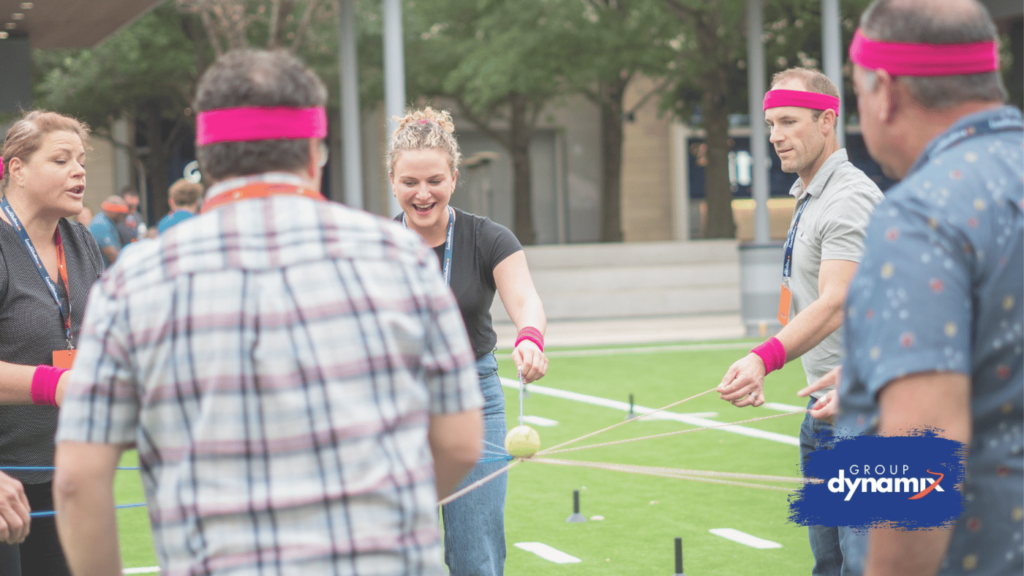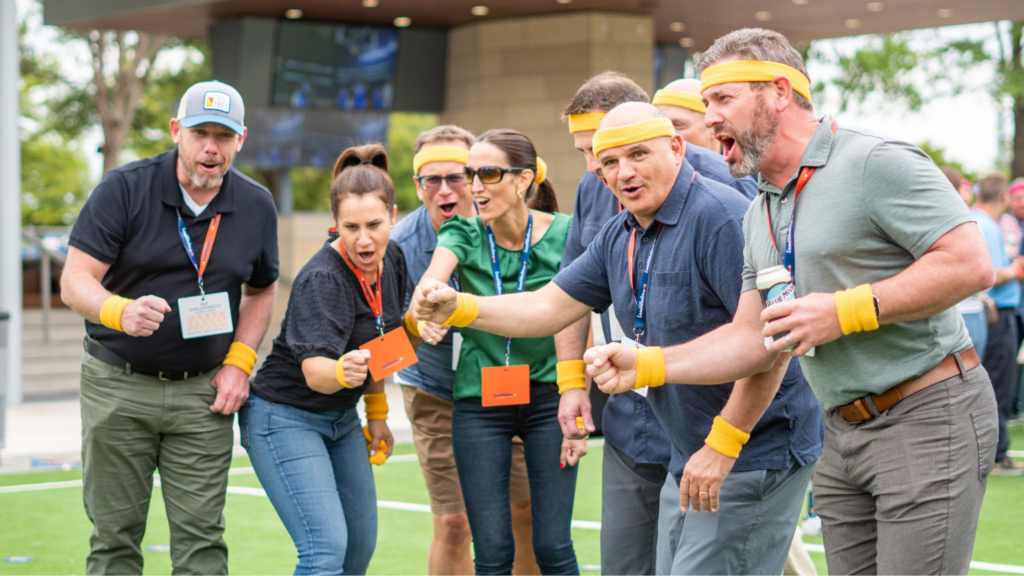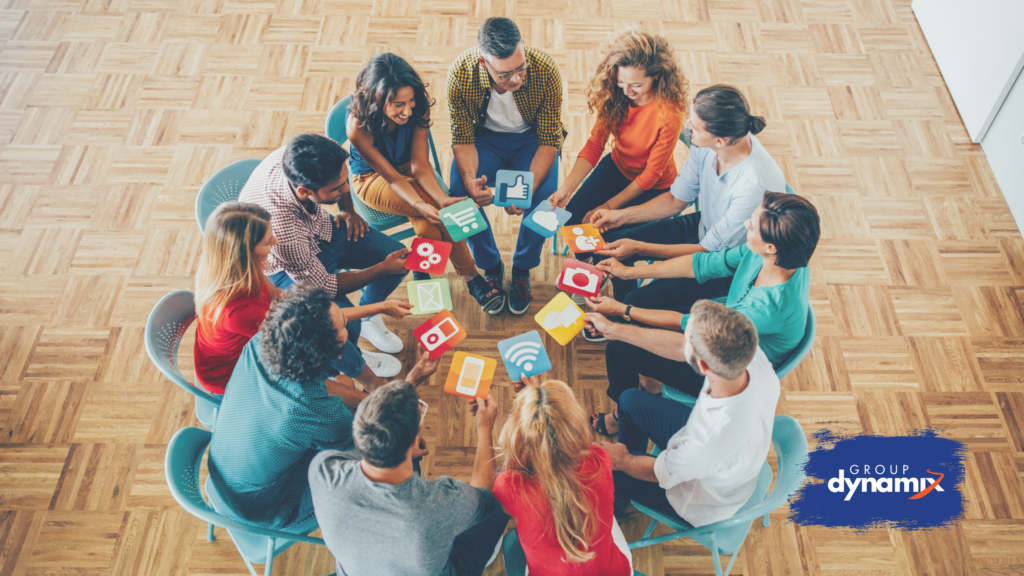Ever watched a room full of strangers transform into an energized, connected group in just minutes? That’s the magic of well-executed icebreakers. Whether you’re leading a corporate retreat, teaching a new class, or hosting a community event, those first 15 minutes can make or break your group’s dynamics. With the right icebreaker activities, even the largest, most diverse groups can quickly shed their hesitation and dive into meaningful engagement.
Discover how Group Dynamix can help you craft the perfect icebreaker tailored to your event.
Group Team Building
Group Team Building
Table of Contents

Benefits of Large Group Icebreakers
Large group icebreakers work like social lubricant that turns a collection of individuals into a cohesive unit. These activities create immediate connections, helping participants see each other as approachable humans rather than just faces in the crowd. When done right, good icebreakers reduce anxiety and create psychological safety—essential ingredients for productive collaboration.
Research shows that fun large group icebreakers do more than just fill time; they actually prime our brains for learning and engagement. By activating the social centers of our minds, these activities increase participation rates by up to 65% in discussions that follow. This brain boost explains why facilitators consistently report higher quality contributions after effective icebreaker activities.
The benefits go beyond immediate interaction. Well-designed icebreakers foster inclusivity by giving everyone equal opportunity to participate, regardless of personality type or position. They level the playing field between extroverts and introverts, executives and entry-level employees, creating shared experiences that people can reference throughout their time together.
Perhaps most importantly, icebreakers set the tone for your entire event. A thoughtfully chosen activity signals to participants whether creativity will be valued, whether vulnerability is safe, and whether the upcoming experience will be worth their full engagement. When people leave their first activity thinking, “That was actually enjoyable,” you’ve already won half the battle for their sustained attention.

Essential Strategies for Successful Icebreakers
Engage Early and Often
The most effective large group icebreaker games don’t wait for silence to settle. They kick off the moment participants enter the room. Research shows that engagement levels drop by 50% after just five minutes of waiting, making those first moments critical. Try having a simple activity ready as people arrive, such as posting intriguing questions on walls for participants to discuss with whoever is nearby.
For maximum impact, plan several short engagement moments rather than a single icebreaker. Brief 2-3 minute activities spaced throughout longer sessions help maintain energy and refocus attention when it inevitably wanders. This layered approach transforms icebreakers from mere opening rituals into strategic engagement tools that sustain connection throughout your event.
Use Partner and Group Dynamics
The psychology behind successful icebreaker games for large groups often involves strategic scaling—starting with one-on-one interactions before expanding to small teams and eventually whole-group activities. This graduated approach builds confidence step by step, allowing participants to find their voice in a safer space before contributing to the larger conversation.
When designing partner activities, make sure they require genuine interaction rather than parallel work. For instance, instead of having pairs separately list their favorite movies, ask them to find three unexpected things they have in common. This interdependence creates authentic connection and prevents the social loafing that can plague larger gatherings.
Ensure Clear Communication
Even the most brilliant icebreaker ideas for large groups fail without crystal-clear instructions. When managing large crowds, remember that noise increases exponentially with each additional participant. Use multiple communication channels simultaneously—verbal instructions, visual demonstrations, and written guidelines—to accommodate different learning styles and environment challenges.
Demonstrating activities with a volunteer before the whole group participates can reduce confusion and hesitation. This modeling approach clarifies expectations and gives participants mental preparation time. For complex activities, consider giving instructions in phases, providing directions for each step only when needed rather than overwhelming participants with all details upfront.
Incorporate Randomized Groupings
Strategic randomization breaks people out of their comfort zones without triggering excessive anxiety. Digital tools like random name generators create truly mixed groupings, preventing the subtle self-segregation that happens when participants choose their own teams. This intentional mixing maximizes exposure to diverse perspectives and experiences.
To execute randomization smoothly, prepare your method in advance—whether using playing cards, colored stickers, or birthdate groupings. The best icebreaker group games balance true randomness with logistical efficiency, ensuring the sorting process itself doesn’t become a momentum-killing delay.
Adapt Flexibly to Group Needs
Reading the room remains an essential skill that no formula can replace. Be prepared to adjust timing, complexity, or physical demands of activities based on real-time feedback. For example, if an icebreaker designed for standing participants needs modification for individuals with mobility considerations, have alternative versions ready that maintain the core engagement principle while changing the format.
Cultural awareness plays a crucial role in flexibility. What works brilliantly in Silicon Valley might fall flat in Singapore. Before selecting icebreakers, research cultural norms around physical contact, personal disclosure, and competition to ensure activities respect all participants. This adaptive approach shows respect while still achieving your engagement goals.

Top 30 Engaging Icebreakers for Large Groups
When facilitating events for dozens or hundreds of participants, having a diverse arsenal of large group icebreaker games is essential. These activities create shared experiences that transform a room of strangers into engaged collaborators. Below are 30 field-tested icebreakers designed specifically to work with larger numbers, each adaptable to various professional and social contexts.
1. Guess the Celebrity
This classic becomes especially effective with large groups as it creates immediate conversation starters. Place celebrity names on adhesive notes and stick one on each participant’s forehead without revealing who it is. Participants mingle, asking yes/no questions to others about their own celebrity identity. The beauty of this game for large gatherings is that it forces movement and creates natural conversation flows, preventing the awkward clustering that often happens in big events.
2. Two Truths and a Lie
Among icebreakers for large work groups, this remains a favorite because it scales beautifully. Have participants write their two truths and one lie on index cards. In groups of 6-8, members share their statements while others vote on which is the lie. For truly large groups, select random cards to read to everyone, turning individual introductions into an engaging group guessing game that reveals surprising facts about colleagues.
3. “If” Questions
For thoughtful engagement without requiring physical movement, pose hypothetical questions to the entire room. Examples include: “If you could have dinner with anyone living or dead, who would it be?” or “If you suddenly had six months of paid vacation, how would you spend it?” What makes this approach great for large gatherings is that it creates shared knowledge that participants can reference in later conversations.
4. Speed Conversations
Modeled after speed dating, this structured approach ensures everyone meets multiple people quickly. Create a simple prompt card with 3-5 questions, arrange participants in inner and outer circles facing each other, and allow 2-3 minutes of conversation before rotating. This method transforms the overwhelming prospect of meeting dozens of people into a series of manageable, focused interactions.
5. Five Things
Divide your large group into teams of 5-7 people and challenge them to list five things they all have in common (beyond obvious traits like “we’re all humans”). The collaborative nature makes this one of the most effective icebreaker games for large groups because it encourages immediate cooperation toward a shared goal, breaking down barriers more naturally than forced introductions.
6. Word Icebreaker
Display a relevant topic or question on a screen and have participants share the first word that comes to mind. In larger groups, use digital tools like word cloud generators where everyone can submit responses simultaneously from their phones, displaying the collective thinking in real time. This activity visually shows both diversity and commonality of thought within minutes.
7. Ending Story
Start a story with an intriguing opening line, then have participants continue it one sentence at a time. In large groups, this works best by dividing into smaller circles of 10-15 people, with each group creating their own story. The resulting narratives often become humorous reference points throughout your event, creating shared micro-cultures within the larger gathering.
8. Snack Break
Transform a routine refreshment period into an intentional icebreaker by adding a simple prompt. For example, have color-coded snacks and group participants by the colors they choose, or attach conversation starters to snack items. This approach recognizes that many meaningful connections at events happen during breaks and deliberately facilitates those moments.
9. Balloon Stomp
For high-energy groups where physical activity is appropriate, this game combines movement with interaction. Participants tie an inflated balloon to their ankle and try to pop others’ balloons while protecting their own. The playful competition makes this one of the most fun icebreaker games for large groups, instantly boosting energy levels while creating lighthearted shared experiences.
10. Telephone Game
Arrange participants in lines and whisper a complex message to the first person in each line. As the message passes from person to person, inevitably changing, it demonstrates communication challenges in a memorable way. When the final version is revealed alongside the original message, the usually dramatic difference provides both humor and a teaching moment about clear communication.
11. Name and Fun Fact
Update this standard introduction format for large groups by adding a memory challenge. Each person states their name and an interesting fact, but must first repeat the names and facts of several people who went before them. This creates active listening and helps combat the overwhelm of remembering numerous new faces in large settings.
12. Group Mural
Set up large paper canvases around the room with different prompts or themes. Participants contribute to multiple murals with colored markers throughout the event. This visual icebreaker works exceptionally well for large groups because it allows simultaneous engagement without requiring everyone’s attention at once, and creates evolving conversation pieces people naturally gather around.
13. Trivia
Well-designed trivia for large gatherings uses topics that don’t advantage certain professions or backgrounds. Form diverse teams and include rounds covering widely varied subjects—pop culture, history, science, sports, and local knowledge. The competitive yet collaborative format makes this one of the more versatile icebreakers for large groups of adults across different contexts.
14. Bingo
Create bingo cards with squares containing traits, experiences, or accomplishments instead of numbers. Participants mingle to find people who match each square (“Someone who has climbed a mountain” or “Someone who speaks three languages”). This structure gives people permission to approach strangers with a purpose, making initial connections easier in intimidating large group settings.
15. This or That
Designate opposite sides of the room for contrasting choices: “Morning person or night owl?” “Coffee or tea?” “Beach or mountains?” Have participants physically move to their chosen side for each question. The physical movement energizes the room while visually revealing unexpected commonalities across the group, creating natural conversation clusters.
16. Charades
Adapt this classic for large groups by forming teams and having representatives act out industry-specific terms or concepts relevant to your gathering. The shared laughter creates bonds across organizational hierarchies and demographic differences, while the content can reinforce themes of your event in an engaging format.
17. Scavenger Hunt
Digital scavenger hunts work remarkably well for large events. Create a list of photos participants must take with different people or objects, requiring interaction across the room. Have teams submit photos to a shared digital album visible to everyone, creating both competition and collective documentation of the experience.
18. Never Have I Ever
Professionals appreciate a workplace-appropriate version of this game where the revelations center on professional experiences rather than personal ones. Provide five fingers to put down as statements are read: “Never have I ever missed a major deadline” or “Never have I ever fallen asleep during a presentation.” The shared vulnerability creates immediate rapport.
19. 10 Things in Common
In pairs or small groups, participants must identify ten surprising commonalities beyond the obvious. This deceptively simple activity becomes increasingly challenging and humorous as obvious similarities are exhausted. The intensity of the search for connections often creates stronger bonds than more surface-level icebreakers.
20. Talent Show
For multi-day events, announce an upcoming “no-pressure talent showcase” early so participants can prepare if interested. The variety of talents displayed—from traditional performances to quirky skills like speed-stacking cups—humanizes coworkers and creates memorable moments that last far beyond the event itself.
21. Arrange Yourselves
Challenge the group to arrange themselves in order based on various criteria without speaking: birthday month, years at the company, or distance traveled to the event. The silent cooperation required makes this particularly effective for demonstrating team problem-solving capabilities while creating movement in the room.
22. Business Cards
While seemingly traditional, this activity becomes more engaging when each participant writes an unexpected fact on their card before exchanging. The physical reminder helps with name recall, while the personal detail provides conversation starters for subsequent interactions, especially valuable at icebreakers for large work groups.
23. Five Challenge
Create five quick physical or mental challenges participants must complete with different people: rock-paper-scissors, thumb wrestling, word association, counting to 20 with alternating numbers, or mirroring movements. The brief, playful interactions with multiple people break down barriers through shared experiences without requiring lengthy conversation.
24. Food Questions
Food discussions reliably engage diverse groups because everyone eats and most people have opinions about it. Questions like “What’s your go-to comfort food?” or “What food from your childhood do you still love?” reveal cultural backgrounds and personal histories in accessible, non-threatening ways.
25. Share Wins
Begin by having participants share a recent achievement, whether personal or professional. This positive framing creates an atmosphere of celebration and mutual support, while giving insight into what different people value and pursue outside of the immediate context.
26. Crosstown Connections
In this structured networking activity, participants receive cards with specific people they need to meet based on complementary interests, backgrounds, or roles. This targeted approach prevents the randomness that sometimes makes large group interactions feel unproductive, ensuring meaningful connections.
27. Train Station Greetings
Participants greet each other as if they’re in different scenarios: old friends reuniting, suspicious strangers, celebrities meeting fans, or people who think they know each other but can’t remember from where. The playacting reduces inhibitions and introduces humor that carries into subsequent interactions.
28. Vowel Orchestra
Group participants by the first vowel in their first name, then have each vowel group create a distinctive sound. When pointed to by the facilitator, each group makes their sound, creating a symphony of vowels. This absurdly simple activity reliably generates laughter while subtly grouping people for potential follow-up activities.
29. Kram Dralloc
Participants introduce themselves using their name spelled backward, then create an elaborate backstory for this alter-ego. The resulting characters and narratives often become running jokes throughout the event, creating a sense of shared humor even among large groups who won’t all have direct interaction with each other.
30. Must Choose
Present increasingly difficult either/or scenarios where participants must physically move to one side of the room or another—no middle ground allowed. Beginning with simple choices like “chocolate or vanilla” before progressing to “know when you’ll die or know how you’ll die” creates engaging philosophical discussions that reveal values and thinking processes.

Customizing Icebreakers for Your Audience
The difference between a forgettable icebreaker and a transformative one often lies not in the activity itself but in how skillfully it’s tailored to the specific group. Even the most popular icebreaker ideas for large groups can fall flat if they don’t resonate with your particular audience. Customization isn’t just about adding appeal—it’s about creating psychological safety and ensuring everyone can participate meaningfully.
1. Considering Cultural Differences
Cultural awareness transforms generic icebreaker activities for large groups into inclusive experiences that respect diverse backgrounds. In international settings, activities involving physical contact, personal disclosure, or competitive elements may carry different meanings across cultures. For example, Japanese participants might feel uncomfortable with direct eye contact games, while American participants might find them unremarkable.
When planning icebreakers for large work groups, survey the cultural makeup of your team beforehand. Activities that involve physical movements should include modifications for different comfort levels. Replace activities requiring elaborate verbal expression with more visual or action-based alternatives when working with multilingual groups. Most importantly, test activities with representatives from different cultural backgrounds when possible.
The most successful facilitators maintain a “cultural intelligence toolkit”—a collection of icebreaker group games organized by their cultural appropriateness and adaptability. This resource allows quick pivoting when you sense an activity isn’t landing well. Remember that cultural customization isn’t just about avoiding offense; it’s about creating genuine connection points that make diverse participants feel valued and understood.
2. Adapting to Age and Interests
Age-appropriate customization goes beyond simply making activities easier or harder—it’s about aligning with generational reference points and values. When facilitating icebreakers for large groups of adults spanning multiple generations, create activities that allow different age cohorts to showcase their unique strengths without feeling disadvantaged by technological familiarity or physical ability.
Professional interests also provide powerful customization opportunities. Industry-specific trivia, problem-solving scenarios, or shared challenges related to participants’ work create immediate relevance. For technical professionals, incorporate logical puzzles; for creative industries, emphasize visualization exercises; for service roles, focus on empathetic listening activities.
Digital natives respond particularly well to icebreakers incorporating smartphone interaction, while mixed-generation groups often connect more authentically through analog activities requiring face-to-face communication. The key is providing multiple pathways to success so that no single skill set or knowledge base determines who can fully participate.
3. Balancing Fun and Purpose
Every effective icebreaker serves dual purposes: creating social connection while advancing your event’s objectives. The most impactful icebreaker ideas for large groups maintain a careful balance between lighthearted engagement and meaningful purpose. When activities feel purely recreational without clear relevance, participants often disengage mentally even while physically participating.
Link icebreakers explicitly to your event’s themes by incorporating relevant vocabulary, concepts, or challenges. For leadership retreats, choose activities highlighting decision-making or delegation; for innovation workshops, emphasize creative thinking; for team-building events, focus on collaborative problem-solving. This integration makes the transition from icebreaker to main content feel natural rather than disjointed.
Professional adults appreciate understanding the “why” behind activities. Briefly explain how each icebreaker connects to your objectives, but keep this framing concise to avoid over-intellectualizing the experience. The most effective activities create enjoyment that feels earned through meaningful engagement rather than forced through artificial enthusiasm.
Strategic customization ultimately creates a virtuous cycle: when participants experience thoughtfully tailored activities, they engage more authentically, which in turn creates richer connections. This investment in audience-centered design transforms icebreakers from perfunctory rituals into powerful tools for achieving your event’s deepest objectives.
Large Group Company Events
Corporate Events, Group Outings, Private Events, Charities, Meetings, and More...
Large Group Company Events
Corporate Events, Group Outings, Private Events, Charities, Meetings, and More...
Conclusion: Elevate Group Members’ Experience
The best icebreakers for large groups enhance connections and collaboration. This guide offers activities designed to break down barriers and foster genuine engagement. When chosen and facilitated well, these exercises create psychological safety that lasts beyond the initial activity.
Focus on progression rather than perfection. Begin with low-risk activities to build trust before moving to deeper, more vulnerable exercises. Pay attention to engagement signals like laughter and spontaneous conversations, which indicate successful connection.
Effective large group icebreakers create ripple effects throughout your event. When participants feel seen and valued, they engage more deeply in subsequent activities. We encourage you to experiment with different activities while adapting them to your context, transforming individuals into a connected, collaborative community ready to achieve remarkable outcomes.
Are you ready to transform your group into a connected and collaborative community? Discover the impactful icebreaker activities that Group Dynamix offers! Whether you’re looking to enhance engagement or foster deeper connections, our tailored solutions can help you create an unforgettable experience. Visit Group Dynamix today to learn more and start planning your next event!

